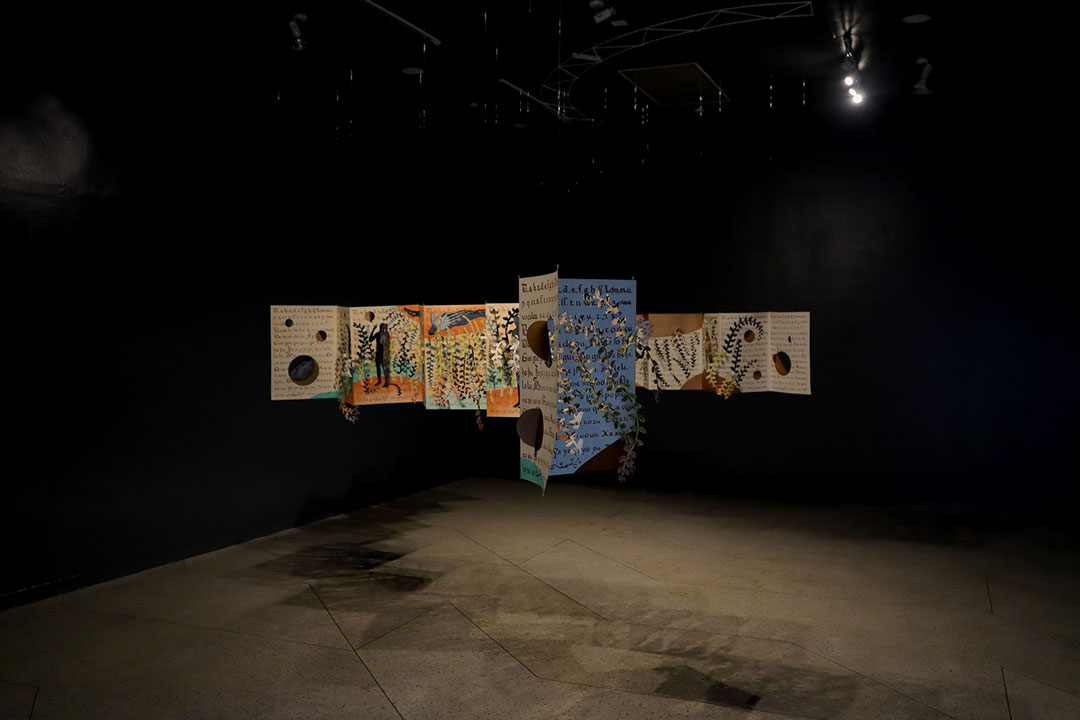
Tracing one’s identity through the past

FOR Filipino visual artist Lee Paje and Thai photographer Ampannee Satoh, looking to the past is an essential part of understanding one’s identity.
The former uses installations and sculptures to reflect on historical narratives that have shaped Filipino queerness, while the latter channels in photographs the lasting effects of political unrest across time and borders from the perspective of a Thai Muslim woman.
At the Vargas Museum in the University of the Philippines Diliman, their takes on inherited realities hang on the walls and from the ceiling, tracing identities inextricably linked to the past. Ms. Paje’s exhibition is titled Beyond the Edge, Embodied Horizons while Ms. Satoh’s is called Ports of Refuge.
“While completely different from each other, their respective artistic practices have a shared sense of exploration. It’s also a coincidence that both Lee and Ampannee are showing works from their residencies,” said Tessa Maria Guazon, Vargas Museum curator, at a walkthrough of the two exhibitions.
HISTORIES UNBOUNDMs. Paje’s main installation, Unbound, is a large-scale piece that incorporates painting, printmaking, and sculpture. It was made using historical archival text from the Doctrina Christiana, repeatedly printed on a Leporello book and then painted over and cut out to form a three-dimensional work.
It was made during the artist’s Pazifik-Leipzig residency in Leipzig, Germany, where she got an opportunity to reflect on the printing press.
“The first printed book here in the Philippines is the Doctrina Christiana. I looked at a historical archive online for a digital copy of the book. On the first page, instead of prayers and sacraments, I saw the Spanish alphabet,” Ms. Paje explained.
This first page then became the printing matrix or visual motif that was printed over and over on the pages.
“It struck me because it reflects how colonialism penetrated this country, how the ways we were colonized inculcated in us the knowledge, worldviews, and power structures that are in place up to now. It has residue in how we view things like gender and identity,” she added.
In altering the form of a book, her work aims to “create possible realities not bound by the text,” she told BusinessWorld.
At the exhibit’s opening in May, a body, sound, and movement performance was held, featuring dancers Deborah Lemuel, Serena Magiliw, Opaline Santos, and Jasper Villasis. The performance had them dance and interact with the paper installation work. “My art also talks about the colonized body, being defined by others outside of ourselves, so it made sense to me to have bodies here perform and interpret that,” Ms. Paje said.
POINTS OF CONFLUENCECo-presented with Shutter Space Studios and Silver Fine Art Prints, Ms. Satoh’s exhibit of monochrome photographs is a sobering look at two different places with once-thriving ports of trade — the artist’s hometown of Pattani in the majority Muslim provinces of Southern Thailand, and Port de La Rochelle on the southwest coast of France.
A recurring motif in many of the photographs is a Muslim woman in a hijab, taken from behind as she faces the horizon. Similar to the case in the Philippines where Christians outnumber Muslims even in Mindanao which is home to 95% of Filipino Muslims, Muslims in Southern Thailand are a minority compared to the Buddhist majority. Both Mindanao and Southern Thailand have had problems with Muslim insurgencies.
“The photographs reflect the political state of our community, and how it affects the women,” Ms. Satoh explained. She then draws parallels with Muslims in France, who are restricted by a controversial regulation that bans wearing burkas in public places.
While little remains of the historical port of Pattani and of the old towers marking the La Rochelle slave-trade port, the artist draws from the rich, vastly different histories of both places. The photos were taken during her artist residency at Centre Intermondes in La Rochelle.
“I look back in the past and feel like I know myself better. I do that to try to see something, and when I did, I felt like I learned more,” Ms. Satoh told BusinessWorld.
The sole video in her exhibition shows a fisherman on a boat on the shores of Pattani Bay, saying his prayers.
Lee Paje’s Beyond the Edge, Embodied Horizons and Ampannee Satoh’s Ports of Refuge run until June 18 at the Vargas Museum, Roxas Ave., UP Diliman, Quezon City.
The museum has admission fees of P20 for students, P40 for seniors, PWDs, and UP staff, faculty, and alumni, and P50 for non-UP visitors. — Brontë H. Lacsamana



